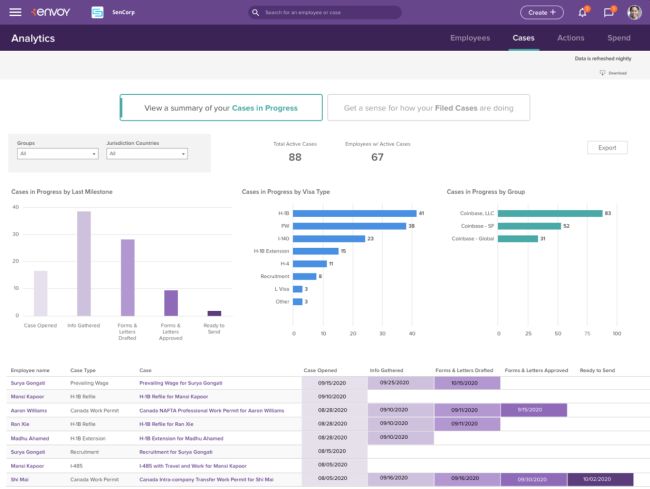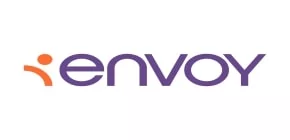Like many present-day HR functions, immigration and mobility programs are best set up for success when driven by data.
In the modern corporate mobility landscape, HR teams are tasked with tracking a high volume of immigration statuses and cases for foreign national employees and estimating costs for future immigration spending. With a range of information that needs to be tracked within an immigration program – sometimes by multiple stakeholders in various interfaces – it's crucial for HR teams to maintain accurate and real-time data.
Today's technology allows for a high degree of integration between HRIS systems and an immigration service provider's case management system. Two-way data feeds may be customized, such as Envoy's ability to integrate seamlessly with HRIS systems like Workday, HRIS NAME and more.
A common bottleneck for immigration and mobility programs is filtering through an excess of data points for their reporting. To build a data-first immigration program, HR and mobility teams can utilize immigration technology and determine the criteria that best meets their organization's needs.
Immigration Data Dashboards: The Stakeholders, Inputs and Audiences
An "immigration data dashboard" is a blanket term to describe the various data points that organizations may need to track in order oversee immigration cases, manage budgets and more. Internally, many organizations and immigration law firms may refer to these data dashboards as "case status reports" or "employee expiration reports." These are all tools designed to keep teams organized and foster the retention of foreign national employees.
There are three key questions for HR and mobility teams to ask when determining the criteria for their immigration data dashboards:
- Who are the stakeholders?
- What are the inputs?
- Who are the audiences?
Who are the stakeholders for immigration data dashboards?
Key stakeholders will contribute to immigration data dashboards, and they may be inside or outside of the organization.
Foreign national employees are commonly the subject of data
points. HR, mobility teams and immigration legal counsel contribute
to tracking the data points about these foreign national employees
in the dashboards.
Foreign national employees provide biographical information,
immigration history, educational information and more, typically
through an immigration case questionnaire or case management
platform. Then, HR and mobility teams can use
these platforms to aggregate foreign national employee data into
robust immigration data dashboards.
Immigration legal counsel manages the progress of cases by marking key milestones in the preparation of an immigration petition or application and government processing updates. Aggregating these updates into a dashboard enables HR and mobility teams to understand what actions need to be taken for ongoing immigration cases.
What are the inputs for immigration data dashboards?
The inputs for immigration data dashboards can vary depending on the size and scope of an organization. There are typically five core buckets that data can be divided into:
- Employment data. Includes job titles, job descriptions, compensation, manager information and other details depending on the organization and the type of visa involved in the immigration cases.
- Foreign national employee information. Includes personal details, family, education, immigration history, job history and other details depending on the employee's background.
- Case progress and details. Includes case and government processing milestones.
- Immigration status. Includes visa expirations for foreign national employees, max-out dates and eligibility for green card sponsorship. There may be other details depending on the organization.
- Case costs and projections for future immigration spend.
While these five buckets contain common inputs required for most immigration reporting, organizations may need to track additional datapoints if they sponsor employees for a wide range of U.S. employment-based visas or manage a global workforce of employees that require sponsorship in other countries.
Who are the audiences for immigration data dashboards?
This is the final, and perhaps most important, of the three questions because the audiences will determine how immigration and mobility data should be filtered into a distributable report. In addition to acting as stakeholders in the process, HR and mobility teams are also often the main audience for immigration data dashboards as they make decisions for the organization based off the data.
For many organizations, HR and mobility teams delegate the task of compiling immigration data dashboards to the immigration legal counsel or global mobility services provider. In these instances, HR and mobility teams should oversee the delivery of the dashboards to ensure it is suited to the needs and timeframes of their organization.
Moreover, immigration data dashboards on case cost and future immigration spend may need to be distributed to other teams within an organization, including:
- HR Managers
- HR Directors
- VP of HR
- CHRO
- CFO
- CEO
The Envoy Global platform offers HR and mobility team users the ability to view and manage snapshots of their organization's immigration data dashboards, as well as the option to request customizable reports for their unique needs.

A Blueprint for Developing Immigration Data Dashboards
With an understanding of the stakeholders, inputs and audiences involved in immigration data dashboards, HR and mobility teams can next begin to develop the criteria for their organization's needs. There are four common types of dashboards that offer regular use for most immigration and global mobility programs:
- Case Status Reports track the progress of an organization's immigration cases. Given that different case types (U.S. vs. global, nonimmigrant vs. immigrant, etc.) may have different case milestones, multiple case status reports may be helpful for HR and mobility teams to clearly oversee progress.
- Foreign National Population (or Expiration) Reports can help HR and mobility teams get a real-time understanding of their foreign national employee population, as well as the immigration needs of each employee. For example, employees that may max out of H-1B or L-1 status may be eligible for a green card and tracking those max-out dates through reporting can help HR and mobility teams determine when to initiate the green card sponsorship process. These reports are particularly important for fast-growing organizations that are hiring large numbers of foreign national employees.
- Cost Reports enable HR and mobility teams to manage all immigration-related expenses for their organization and make projections for future immigration spending levels to include in their budgets.
- Data Integrity Reports can often be overlooked but ensuring that immigration and mobility data is accurate is key for maintaining efficient processes and avoiding costly mistakes. These reports can contain some or all the inputs in the reports above and can be conducted on a regular basis to ensure data integrity.
Depending on the needs of their program, organizations may require these dashboards at various time intervals. While case status reports may be useful on a weekly or biweekly basis, cost reports may only be needed on a quarterly basis. With immigration technology platforms, HR and mobility teams are enabled to manage their organization's data dashboards and create comprehensive reports in seconds.
For more content on strategies for managing an immigration and mobility program, check out Envoy's HR Strategies page.
Originally published 10 October 2022
The content of this article is intended to provide a general guide to the subject matter. Specialist advice should be sought about your specific circumstances.

